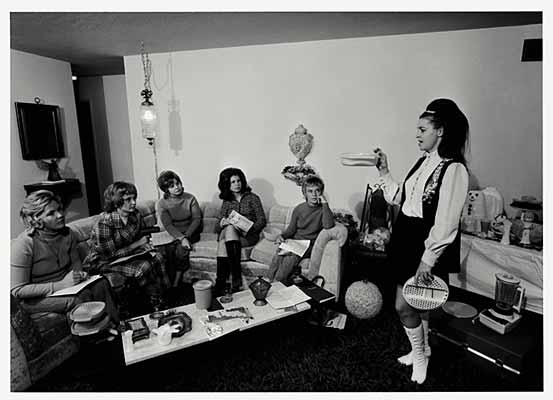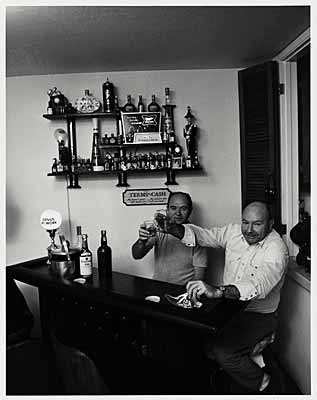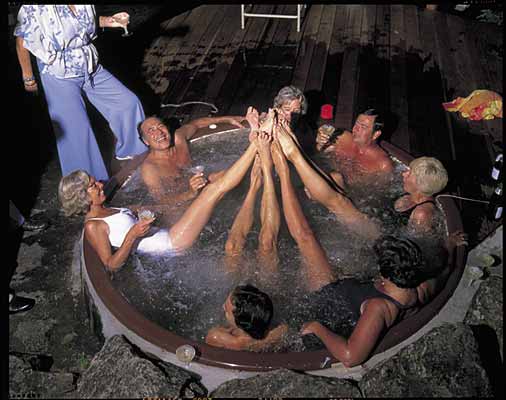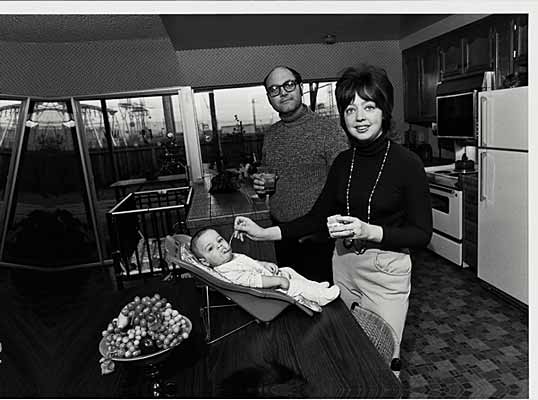


|
THE SUBURBAN
SEVENTIES: PHOTOGRAPHS by BILL OWENS AT THE SAN JOSE MUSEUM OF
ART Nestled in the heart of downtown San Jose next to the Fairmont Hotel, you will find two buildings merged together-- one old and one new. It may not be the most esthetically pleasing combination, but somehow it works and also functions as a metaphor for the San Jose Museum of Art. The older building was the original museum and now houses the Museum Café and Museum Store. Linked to the Historic Wing is the modern addition with a large red banner proclaiming its identity. The museum, like the city it is located, strives to define itself by looking forward and yet acknowledging its past.
Addition
to Historic Wing
The exhibits we viewed on our recent visit certainly reflect this blending of past and present. CURRENT EXHIBITS There were two primary exhibits available on the day we visited the San Jose Museum of Art: Surroundings: Responses
to the American Landscape. Selections from the Whitney Museum
of American Art, June 6, 1999 - June 11, 2000. Many artists, movements, and styles combine in this exhibit to articulate the diversity of the American landscape. Not to be missed is Edward Hopper's Railroad Sunset, 1929. The isolated train outpost building provides a stark contrast to a most spectacular sunset. While we were interested in seeing the Surrounding's exhibit, we were even more excited about the other featured exhibit. The Suburban Seventies: Photographs by Bill Owens, January 23 - April 2, 2000. THE SUBURBAN SEVENTIES: PHOTOGRAPHS by BILL OWENS Open spaces, new home
developments, Tupperware parties, big hair curlers, pant suits,
bad hair, drinking, and hot tub parties. These are just some of
the images seen in the photographs of Bill Owens that define an
era. At times funny, poignant, or uncomfortable, Owens' photographs
can be understood as a mirror to our not-so distant past.
The photographs seen
in this exhibit were taken in 1972 and were published a year later
in a book called "Suburbia." At the time of publication only a
year had passed and many of Owens' images of the American Dream
in the new housing sprawl of the Livermore Valley (California)
would not have the resonance and perspective they now possess.
"We don't have
to conform" We may be amused by
the tackiness of the dated clothes and hairstyles, but there is
a powerful and intriguing sense of optimism that permeates all
these photographs. Owens has somehow more than merely entered
and photographed his subjects' homes-he has also managed to permeate
and capture the people themselves.
The people who attended the museum on the day we visited seemed to thoroughly enjoy the exhibit. Whether they laughed loudly or closely examined the many of the details of the pictures, everyone really seemed to understand and connect with the people captured on film. While looking at one of the photographs, a fellow viewer laughed and said to us: " It's amazing how he (Owens) captures the person. It's almost like he's their best buddy." This comment represents the intriguing quality of these images. It is hard to understand why they would have been originally published only a year after they were taken. After all, there would be little, if any, perspective to fully understand who these individuals are. But almost thirty years later the effect is quite different. We are now able to recognize that regardless of the era, people are people. There will always be a deep desire to carve out one's own piece of the American Dream. Read
Art a GoGo's Interview with Bill Owens MUSEUM RATING Because the building itself is smaller, there are fewer exhibits and less emphasis on the museum's permanent collection. This can make your experience less daunting because you will actually be more motivated to take the time to see all the exhibits. The galleries are spacious and well-lit and were not too crowded on the day we visited. We felt unrushed as we took a leisurely pace through the galleries. Not to be missed is the site-specific installation seen through the back doors in the museum foyer. "Burnt Patch," 1995 by Andy Goldsworthy consists of arranged pine sticks with a charred center. It may look haphazard but remember that each stick has been carefully placed by the artist. We wondered what would happen to all those sticks on a very windy day… Perhaps the best day to visit the San Jose Museum of Art is the first Thursday of each month…it's FREE! Regardless of when you visit, you can plan a picnic in nearby Caesar Chavez Park or have lunch or dinner at one of the many restaurants that are close to the museum. For more details, visit
the San Jose Museum of Art web
site
Purchase "Suburbia" by Bill Owens! Suburbia
|




